Chapter 9 Study Guide (The Muscular System)
1/73
There's no tags or description
Looks like no tags are added yet.
Name | Mastery | Learn | Test | Matching | Spaced |
|---|
No study sessions yet.
74 Terms
Skeletal Muscle Tissue
A type of muscular tissue that is striated, under voluntary control, multinucleated, and attached to bones.
Cardiac Muscle Tissue
A type of muscular tissue that is striated, under involuntary control, has a single nucleus, has intercalated discs, and is found in the heart.
Smooth Muscle Tissue
A type of muscular tissue that is non-striated, under involuntary control, has a single nucleus, and is found in hollow organs.
Produces Skeletal Movement: Contacting muscles cause movement. Muscles pull on tendons to move bones.
Stabilizes Body Position and Posture: Even while not moving, muscles contract to keep us upright. Constant muscular contraction prevents us from just collapsing.
Supports Soft Tissues: Supports organs in abdominopelvic cavity, since they don’t have much structure. The muscles line the cavity to protect internal tissues and organs.
Stores and Move Substances throughout the Body: Hollow organs, hollow sacs of muscle, store substances and move substances along. These organs have rings of muscular tissue called sphincters and they contract to prevent organs from loosing substance. Muscles provide voluntary control over swallowing, defecation, and urination.
Thermogenesis: Generates heat whenever muscles contract. Shivering, working out, breaks ATP and generates body heat. Maintains body temperature.
Functions of the Muscular Tissue
Excitability: Respond to stimulation.
Contractibility: Can shorten actively and exert pull or tension.
Extensibility: Can contract over a range of resting lengths.
Elasticity: Ability of muscle to return to original length after contraction.
Properties of Muscle Tissue
Skeletal Muscle Tissue
Connective Tissues: Areolar, dense irregular, adipose, elastic, etc.
Blood vessels: Blood flow is needed because muscles need nutrients to function and produce ATP.
Nerves: Helps muscles contract
Subcutaneous Layer: Insulates and protects. Areolar and adipose tissue.
Tissues and components of muscles that make them organs
Fascia
The dense irregular connective tissue that wraps around muscles. It supports muscles and organs, lines body cavities, and is around limbs. Provides pathway for blood vessels and nerves to access muscle tissue. Some will have stem cells inside to repair muscle tissues.
Fascicle
A bundle of muscle fibers. Vary in the number of muscle fibers inside.
Endomysium
The fascia around each muscle fiber. Lined with specialized cells called myosatelite cells, they surround every muscle fiber and repair muscle fibers. It binds muscle fiber to its neighbor and supports capillaries. Consists of delicate network of reticular fibers.
Perimysium
The fascia that surrounds the fascicles. Divide the muscle into internal compartments. Contain bundle of muscle fibers, fascicles. Also contains collagen and elastic fibers, blood vessels, and nerves.
Epimysium
The fascia that is outside (surrounds) the muscle. Dense irregular connective tissue surrounding entire skeletal muscle. Separates muscle from surrounding tissues and organs. Connected to deep fascia.
Tendon
The dense regular connective tissue that attaches muscle facia to bone periosteum. Attaches muscle to bone, cartilage, skin, or other muscles. Continuous with periosteum, makes strong bond so any contraction of muscle pulls on attached bone.
Aponeurosis
Broad and flat tendons. They are tendons that form thick and flattened sheets.
Fibromyalgia
A connective tissue disorder/disease that is the inflammation of tendons and muscles. Symptoms include pain, fatigue, and stiffness in joints. Causes are unknown but could be immune system related. Treatments include antibiotics, rest, and exercise.
Tendinitis
A connective tissue disorder/disease that is the inflammation of tendons due to repetitive use. Symptoms include pain in joints and tendons. The tendons don’t have much blood flow so it takes longer to heal. It is common in the elderly and athletes that use specific tendons repetitively. Treatment includes rest and the reduction of movement. The repetitive use causes microscopic tears to accumulate in the tendon over time.
Every skeletal muscle fiber is connected to one nerve.
One nerve may connect with multiple muscle fibers.
Nerves lie within connective tissues.
Nerves are bundle of axons that enter the epimysium, branch through perimysium, and enter endomysium to attach to muscle fibers.
Motor unit: One neuron and all the muscle fibers it is connected to.
Nerves stimulate contraction.
Nerve Supply of Muscles
Muscles require a lot of blood flow (nutrients, oxygen, waste removal).
Every time a muscle contracts, they consume oxygen, glucose, and make waste.
Blood vessels deliver oxygen and nutrients needed to produce energy in the form of ATP in skeletal muscles.
In the endomysium, arteries supply a large capillary network.
Capillaries are coiled.
Blood Supply of Muscles
Muscle Fiber
A muscle cell.
They span the entire length of their muscle.
During embryonic development, myoblasts fuse together to make one very long muscle fiber.
Long and cylindrical.
Striated: Organization of myofibrils and their molecular components give skeletal muscle a striated appearance.
Polynucleated (one nucleus for each myoblast that fuse together)
Muscles cannot reproduce.
Muscle Fiber Characteristics
Myoblasts
Muscle stem cells. Embryonic cells that fuse to form individual skeletal muscle fibers.
Myosatellite Cells
When myoblasts don’t fuse with muscle fibers but remain in adult skeletal muscle tissue as stem cells. When muscle is injured, these cells differentiate and assist in repairing and regenerating muscle.
Sarcolemma
The plasma membrane of the muscle fiber.
Transverse (T) Tubules
A structure of the muscle fiber that is an extension of the sarcolemma in the form of tubes. IT wraps around organelles. Deep indentations in sarcolemma surface form these. Extend into sarcoplasm. These structures and sarcolemma conduct electrical impulses called action potentials, to stimulate muscle fiber contraction.
Sarcoplasm
The cytoplasm of the muscle fiber. It is the space in the fibers. Anything inside sarcolemma. Contains a lot of proteins called myoglobin.
Myoglobin
Oxygen-storing protein in the sarcoplasm of a muscle fiber. Muscle fibers are able to store excess oxygen for when mitochondria need them. They are red in color because of the iron that is necessary to bind oxygen molecule, allows muscle cells to store oxygen.
Myofibrils
Contracting organelles in the muscle fiber. Contain mitochondria and glycogen granules scattered throughout to provide ATP to power contractions. Lie parallel and along the whole length of the muscle fiber. Made of cytoskeletal filaments (myofilaments). They are fine cylindrical fibers. The active shortening is responsible for muscle fiber contraction.
Sarcoplasmic Reticulum (SR)
A structure in the muscle fiber that stores calcium ions which contract muscle fibers. They are a series of tubes related to the smooth endoplasmic reticulum. There are enlarge areas at the ends of the tubes. Surrounds each myofibril and controls myofibril contraction. They are the storage and release site of calcium ions.
Terminal Cisternae
The enlarged areas at the ends of the tubes of the SR. Located on each side of T tubule. The tubules of SR enlarge, fuse, and form these expanded chambers.
Triads
A structure within the muscle fiber that consists of two terminal cisternae and 1 transverse (T) tubule in the middle of them.
Myofilaments
Protein filaments that are made of cytoskeleton and allow for contraction. There are two types: thin and thick. They are cytoskeletal microfilaments. Do not run the entire length of myofibril. They are short chopped up pieces. Inside the myofibrils they are held in compartments called a sarcomere.
Thin Filament
A type of filament that contains mostly actin. It also contains regulatory proteins troponin and tropomyosin. Also has myosin binding sites.
Thick Filament
A type of filament that contains myosin. It is at the center of a sarcomere. Composed of bundles of myosin molecules, each made up of a pair of myosin subunits twisted around one another. Long tail is bound to other myosin molecules in filament. Free head, with two globular protein subunits, projects outward toward the nearest thin filament. Myosin heads interact with thin filament during a contraction, they are known as cross-bridges. The heads are motor proteins that uses ATP to pull myosin head along thin filaments. They also have a core of titin.
Sarcomere
One section of myofilaments within a myofibril. This is a name for when myofibrils are organized in repeating units. It is the smallest functional unit of a muscle fiber. It is a subunit of filaments.
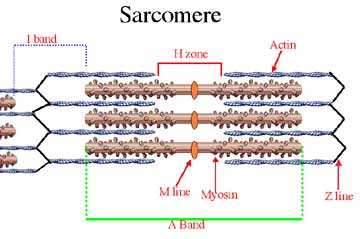
Z discs
A part of the sarcomere that refers to the zig-zag proteins that separate sarcomeres. It bisects the I bands and mark the boundary between adjacent sarcomeres. Made of proteins called actinin, which interconnect thin filaments of adjacent sarcomeres.
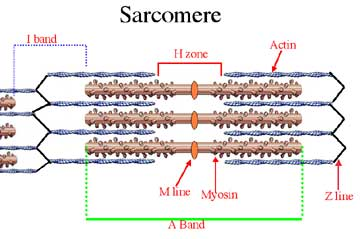
A band
The region of a sarcomere with thick (myosin) filaments. Thick filaments are in the center. It contains the M lines, H band, and zone of overlap.
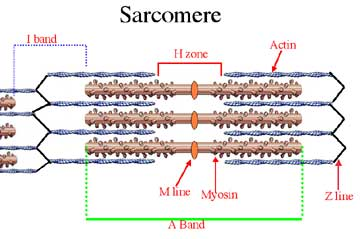
H zone
The part of the sarcomere that refers to the center of the A band, where there are only thick filaments.
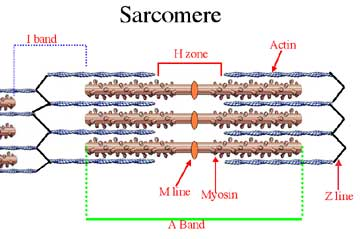
M line
The part of the sarcomere that refers to the center of the H zone. It contains stabilizing proteins that are also at the center of the A band. The proteins connect the central portion of each filament to neighboring thick filaments. It stabilizes the position of thick filaments.
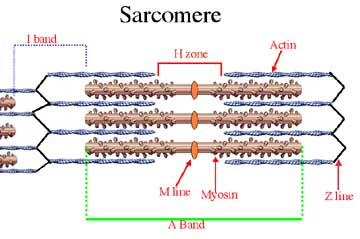
I band
The part of the sarcomere that refers to the area with only thin filaments. It extends from A band of one sarcomere to the A band of the next sarcomere.
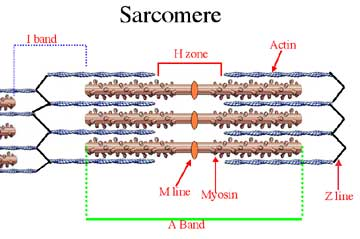
Zone of Overlap
The region of the sarcomere that is where thin filaments are found between thick filaments.
Myosin
A type of contractile protein that is made of two long skinny proteins that are twisted together, and the ends have little rounded club shapes. About 300 of them bundled together make one thick filament.
Actin
A type of contractile protein that is twisted into a helix to form thin filaments. Each protein has a binding site for a myosin head.
Tropomyosin
A type of regulatory protein that forms a long chain that covers the active sites on actin, preventing actin-myosin interactions. They covering binding sites and prevent them from being used when you don’t want to contract the cell.
Troponin
A type of regulatory protein that holds the tropomyosin strand in place. Before a contraction, these molecules must change position, moving the tropomyosin molecules and exposing active sites. They are used to pull tropomyosin off when you want to contract.
Titin
A type of structure